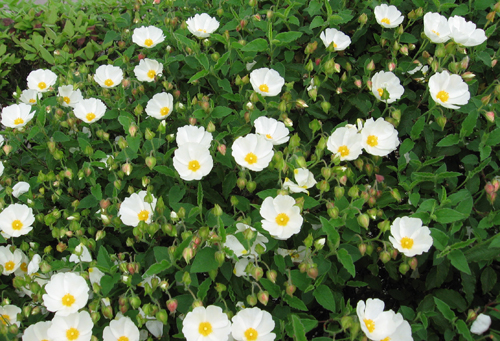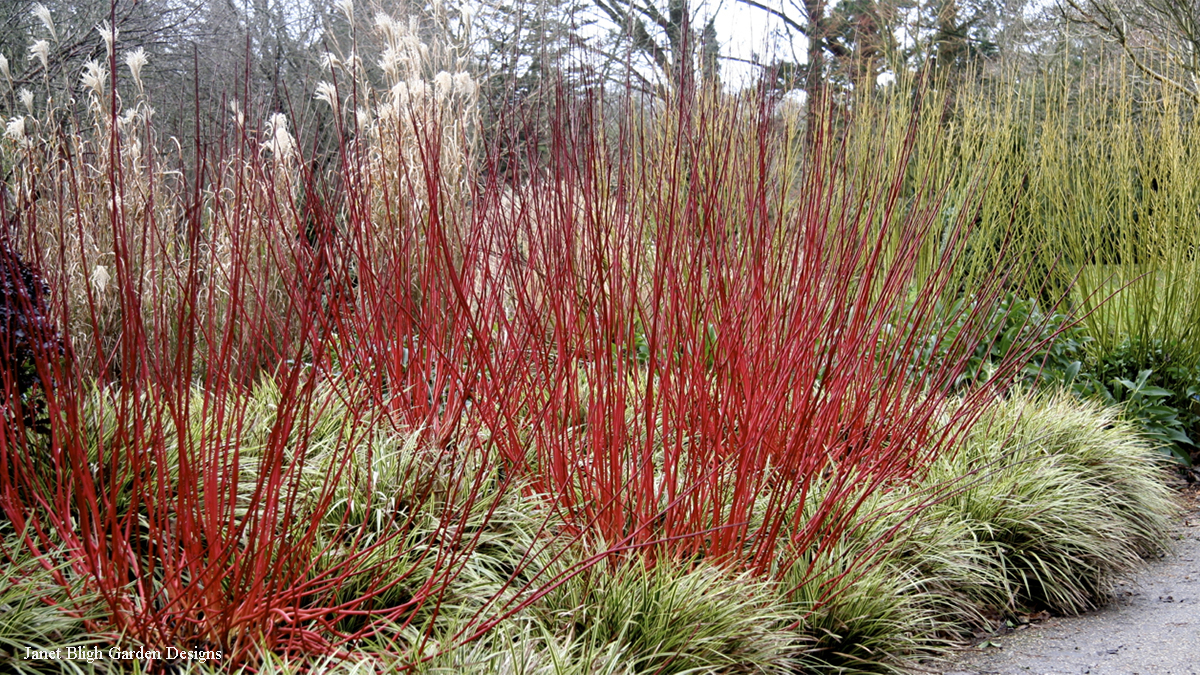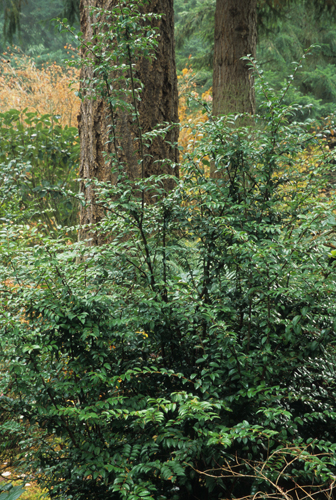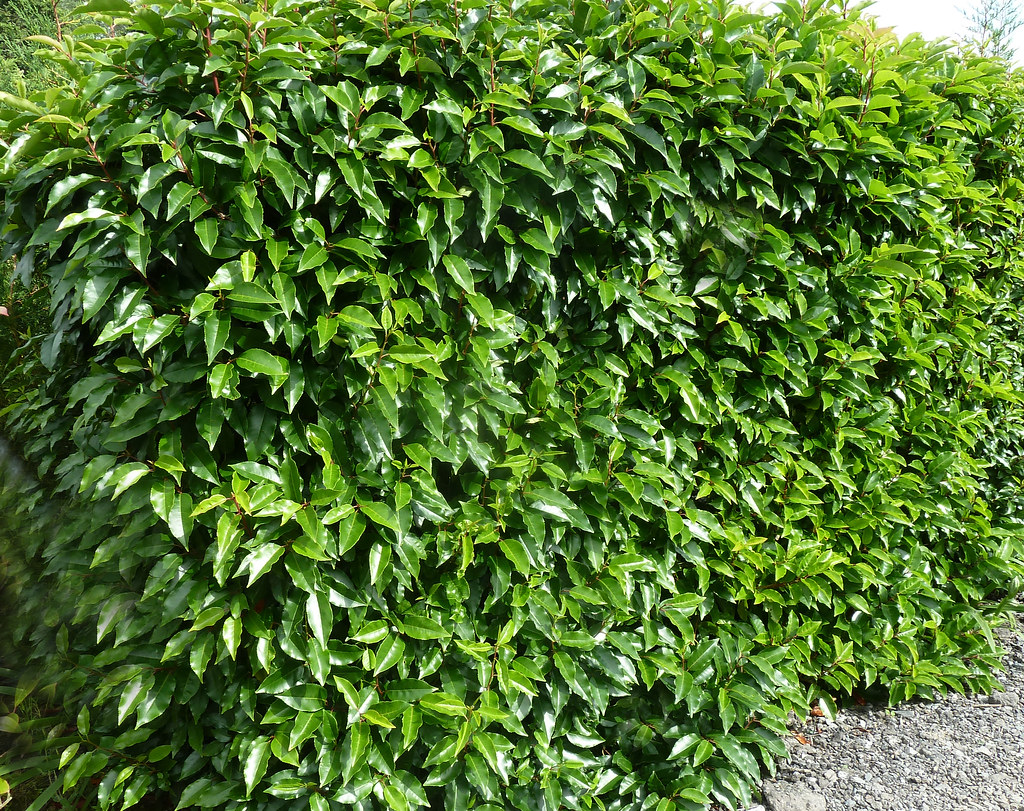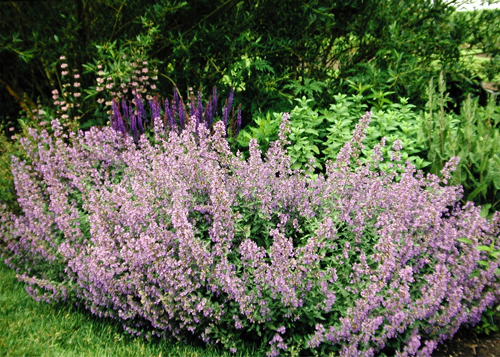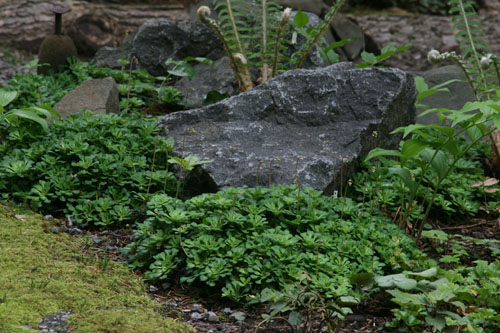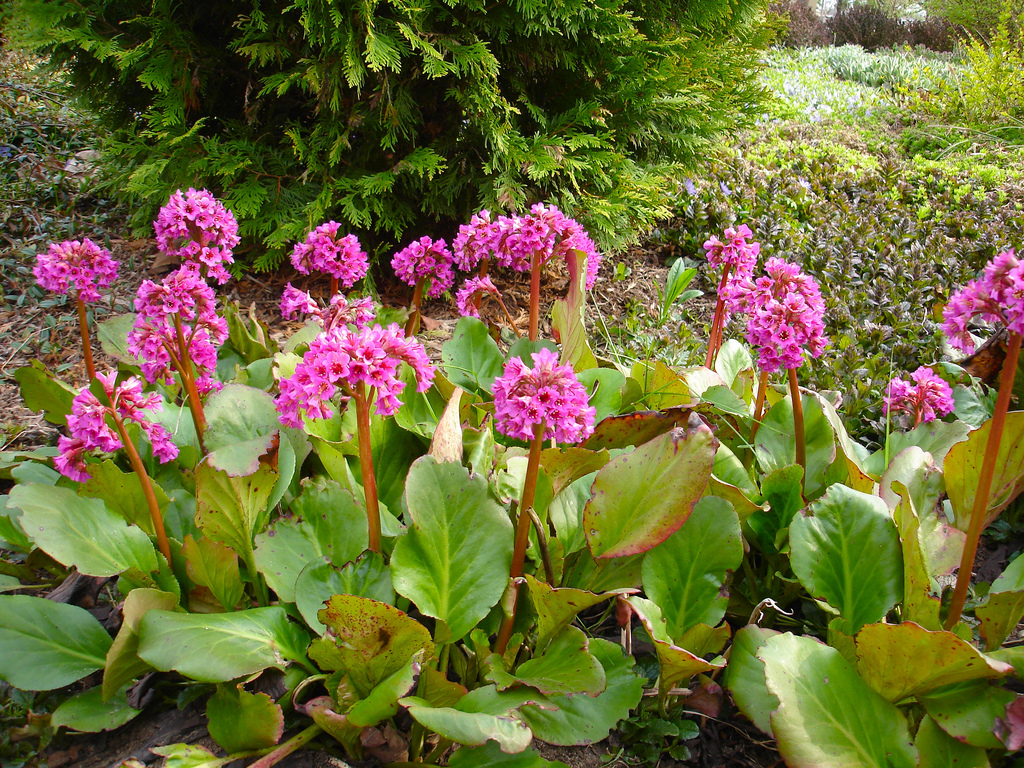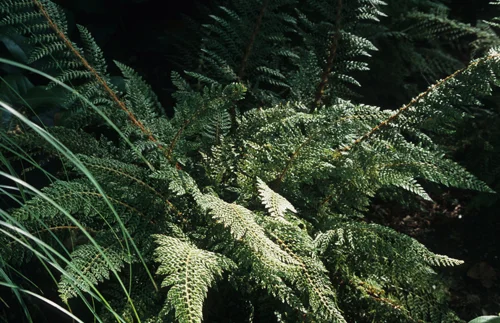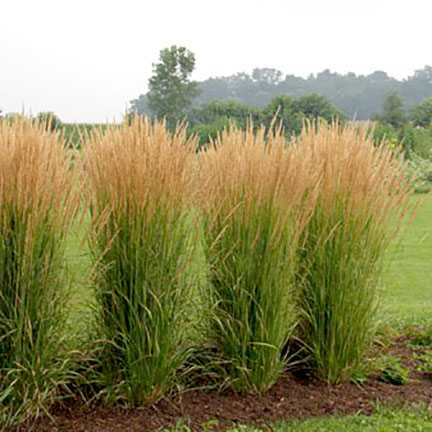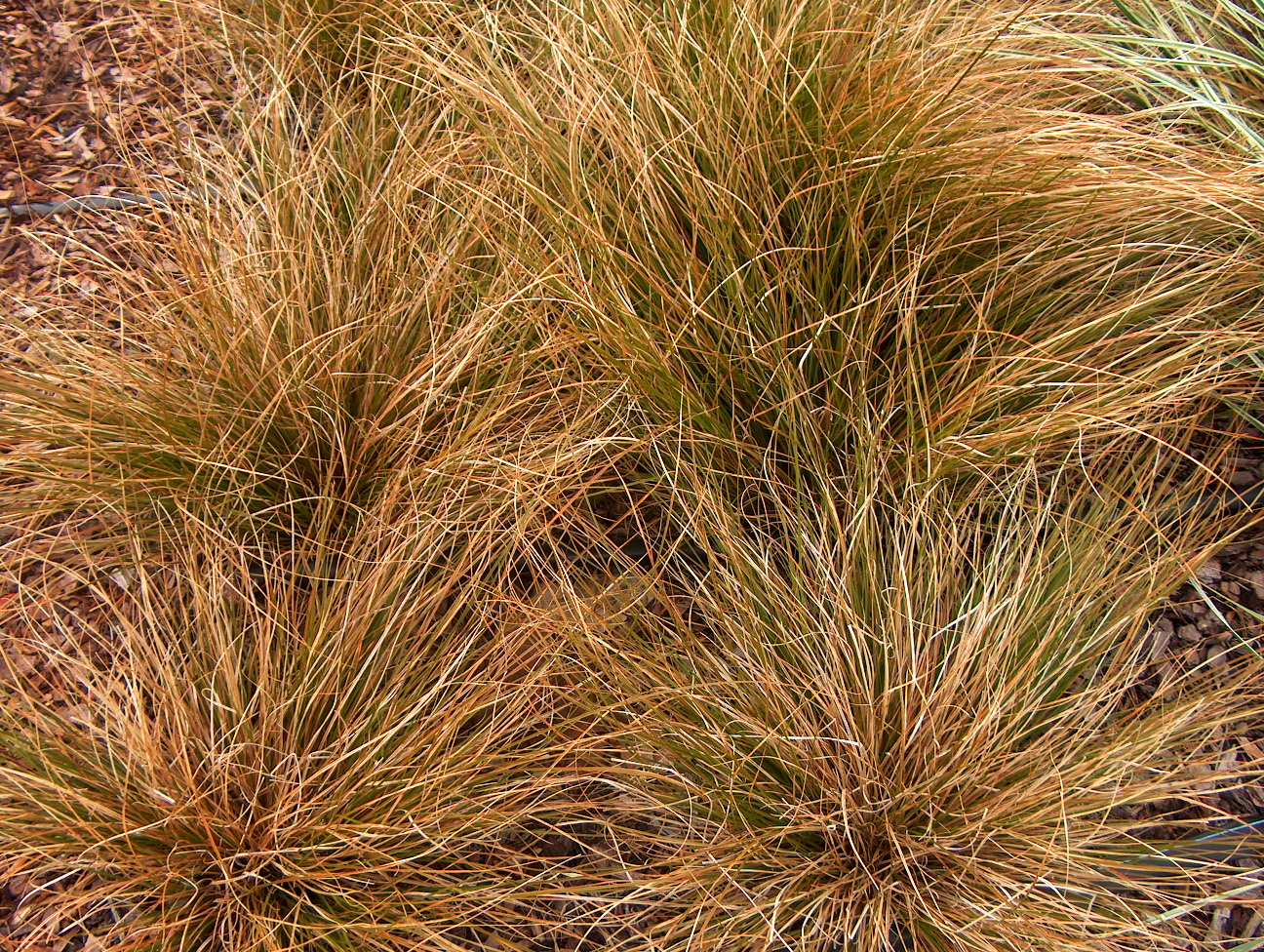Not every plant is destined to be a Garden Superstar.
Every stable needs a thoroughbred but also a team of workhorses. Every musical needs a few divas, but also a solid chorus line. Every killer app development team needs... okay, you get the idea.
Every garden needs a few (or many) plants that might not shout for attention but do their job quietly and dependably. These are often "structural" plants — hedging, screens, groundcovers — or "massing" plants which provide a garden's visual framework or background. Or maybe that one solid shrub in the corner, around which the divas frolic. Such plants are part of the "bones" of the garden. When designing a garden, it's wise to lay these out first to build that framework, then fill in with the showy accents.
The workhorse plants listed below make up for their lack of audacity with attractive form and/or foliage textures. They look good most or all the year, without a lot of fuss. They don't require a lot of pruning, deadheading, fertilizer, or pest treatment.
Many are chosen for public street plantings (along medians and parking strips on major arterials), as they are known to tolerate a variety of growing conditions. They might face extremes of heat, cold, dryness, dog urine, trash, pollutants, etc. Not all the entries here tolerate such extremes, but they do have a relatively easy-to-grow reputation.
My list is neither exhaustive nor will be exactly the same that my colleagues would recommend ("You left off Tasmanian Thingamabob?!?"). Ask three garden professionals and you will get five different opinions. And I omitted some of the usual suspects — boxwood, arborvitae, azaleas, heather, vinca — since many gardeners already know (and sometimes overuse) them.
Here, then, are my choices for dependable, workhorse plants which can add some common sense to your garden and help save it from sensory overload.
Notes:
All are evergreen, unless mentioned as deciduous.
As always, plants listed as drought-tolerant still need two good years of consistent, proper watering to establish a deep root system.
Not all of these are available year-round at Swansons, although we do carry them at times. It's always a good idea to ask about availability via #heyswansons on social media.
Shrubs
Japanese Holly (Ilex crenata)
Tiny, non-prickly, dark, glossy leaves on evergreen shrubs for sun or shade. They can be easily pruned (but don't always need it). The very definition of "versatile." Some popular varieties include:
‘Convexa’: 6-8' H + W, Faster growing with convex leaves give high glossy appearance.
‘Northern Beauty’: 6-8' H x 4-6' W. Slightly larger leaves than most.
‘Green Island’: 3-4' H x 5-6' W. More spreading, open habit.
Shrub Honeysuckle (Lonicera)
Very similar to Japanese hollies in their small glossy leaves, but with a looser, more open habit, and tiny fragrant flowers to boot! Several varieties have golden or variegated leaves. Avoid extremes of dry, sunny spots or deep shade.
Boxleaf Honeysuckle (L. nitida): Rounded, arching shrub, averaging 5-6' H + W. Several colorful varieties available.
Privet Honeysuckle (L. pileata): Low spreader, great groundcover and erosion control plant. 2' H x 8' W.
Shrub Dogwood (Cornus sericea)
Vigorous, multi-stem, deciduous shrubs which also handle a variety of conditions including compacted or damp soils. Valued for their bare winter twigs of (sometimes intense) reds to yellows, as well as flowers and berries that, while not super showy, attract pollinators and birds. Some varieties (of Cornus alba as well as C. sericea) have bright golden or variegated leaves — perhaps diva-looking but easy to work with. Some notable green-leaf varieties:
'Baileyii': The classic Red Twig Dogwood, whose deep red stems light up winter against a dark or snowy backdrop. 8-10' H + W.
'Arctic Fire': All the attraction of the ‘Baileyii’ but smaller: 3-5' H + W.
'Kelseyii': Dense little dwarf with 2-2.5' H + W
'Bud's Yellow': Brightest of the yellow-twigs. 7-8' H x 6-7' W.
Rockrose (Cistus)
Yes, they are showy in flower, but after the show, they fill in nicely as sun-loving, drought-tolerant evergreen shrubs, which can be sheared to stay dense. Some favorites:
White Rockrose (C. x hybridus): Dark green foliage, white blooms with yellow centers in May-June. 5' H + W.
C. skanbergii: Small, sage green leaves and light lavender-pink blooms in May. 2-3' H x 4-5' W.
C. creticus: Low-growing variety with crinkly leaves and hot pink flowers. 2-3' H x 4-5' W.
Dwarf Cherry Laurel (Prunus laurocerasus)
Most laurels are very tough and tolerant of many conditions, but can grow huge and need frequent pruning. This group stays low and compact:
'Mt. Vernon': 2' H x 5' W. Leaves like species but low, groundcover habit. Does not flower or seed.
'Otto Luykens': 4' H + W. Dense habit, leaves somewhat upright.
'Chestnut Hill': 4' H + W. More weeping habit to leaves.
Yew (Taxus)
Common in the eastern U.S., Europe and Asia, and valued for their adaptability to pruning and tolerance of shade and cold, yews are still underused here in the Northwest. There are low spreading forms and upright forms perfect for hedges. Bright red berries (with toxic seeds) add color. The standby upright forms:
Irish Yew (T. baccata 'Fastigiata'): 8-15' H x 3' W.
Hicks Yew (T. x media 'Hicksii'): 12-20' H x 8-12' W.
Vine Maple (Acer circinatum)
This Puget Sound native (related to the Japanese maple) is quite showy in the fall, and often grows to an attractive, sculptural, multi-trunked habit (a "shrubby tree"). But it's often seen as a background plant, not that noticeable until fall color lights up. It’s also very adaptable to sunny or shady locations. 10-25' H x 8-15' W.
Evergreen Huckleberry (Vaccinium ovatum)
Puget Sound native evergreen shrub with tiny, glossy leaves, arching to 5-8' H x 4-5' W. Another adaptable plant for sun or shade. Reddish new leaves, dainty pink-white flowers and edible, dark blue huckleberries.
Salal (Gaultheria shallon)
Puget Sound native evergreen shrub with rounded, leathery leaves, often rambling like a groundcover. Also tolerates sun or shade. 3-5' H + W. Easy to prune back.
Dwarf Yeddo Hawthorn (Rhaphiolepis umbellata ‘MINOR’)
Many Rhaphiolepis have quite spectacular flowers in spring. The dwarf yeddo (or yedda) also has nice white flowers, but qualifies for workhorse status for it’s slow, compact habit and glossy dark green foliage. It just plain looks good all year in sunny, well-drained spots. 3-4' H x 4-5' W.
Hedges & Screens
Pacific Wax Myrtle (Morella californica)
Upright, fast-growing (but not huge), easy to control, somewhat open screening habit, coastal native from southern Oregon into California. Sometimes listed under its older name, Myrica californica. 10-15' H + W.
Laurustinus (Viburnum tinus)
Dark, blue-tinged green leaves and a propensity to bloom on and off through much of the year make this a favorite hedging plant. 6-12' H x 4-8' W. Smaller varieties are popular.
Portugal Laurel (Prunus lusitanica)
Arguably the most attractive of the large laurels, with dark, glossy, leaves that weep somewhat. 10-20' H + W, but easy to keep down to 8-10'.
Perennials
Lavender (Lavandula)
Quite showy in bloom, but these drought-tolerant shrubs make tidy mounds all year if pruned properly twice a year. Most are evergreen and some consistent performers include:
L. x intermedia 'Grosso': Taller, narrow flower spikes. 12-24" H x 12-36" W.
L. angustifolia 'Munstead': More upright habit and dark purple flowers.12-24" H x 12-36" W.
L. angustifolia 'Ana Luisa': Dense habit with silver-gray foliage.12-24" H x 12-36" W.
Elephant Ears (Bergenia)
The bold, glossy leaves of these perennials work well for massing and playing off finer-textured plants. Best in shade to part shade, but they tolerate just about anything. 12-18" H x 18-24" W.
Catmint (Nepeta)
Low shrub for sunny, dry locations. Also long-season bloomer and very attractive to pollinators. 18" H x 30" W.
Daylily (Hemerocallis)
Daylilies may look like fragile bulb plants but are tough! Again, showy in bloom (and long-blooming) but even out of bloom, make a dense, rich green clump all season. Deciduous. 1-2' H x 1-3' W, depending on cultivar.
Groundcovers
Barrenwort (Epimedium)
Also delicate-looking but tough & tolerant. Leathery, heart-shaped leaves on wiry stems, and spritelike flowers in many color options. Varieties from 4 to 24" in height, slowly spreading. Most prefer shade but some do okay in sun with ample watering.
Speedwell (Veronica 'Georgia Blue')
Low (6") groundcover spreads vigorously with bronzy foliage, covered in intense blue flowers through spring and sporadically through summer. 6" H x 3' W.
Stonecrop (Sedum)
Dependable, drought-tolerant succulents for mostly sunny locations. Among the groundcover types, too many varieties and sizes to mention!
Dwarf London Pride (Saxifraga x urbium 'Primuloides')
Whimsical little groundcover for shade. 3-6" H, slowly spreading.
Grasses (or grass-like perennials)
Feather Reed Grass (Calamagrostis x acutiflora 'Karl Foerster')
Upright deciduous grass, perfect for narrow spaces. 5-6' H x 2' W.
ORANGE Sedge (Carex testacea)
Many of the Japanese sedges have showy variegations, but they are versatile and dependable, too. Orange sedge is a fine-textured grass good for massing in sun to part shade. Its blades are olive green with bright orange tips in winter (brighter in sun). 18-24" H + W.
Moor Grass (Sesleria autumnalis)
Bright green, attractive clumping grass with downy white seed heads that display in fall and winter. 18-24" H + W.
Ferns
Sword fern (Polystichum munitum)
Our stalwart Northwest native that grows nearly anywhere. 3' H + W.
Shield fern (Polystichum setiferum Divisilobum)
Low, spreading, architecturally interesting ferns which tolerate dry shade. 2' H + W.
Tassel fern (Polystichum polyblepharum)
Lush, rosette form with coppery stems. 2' H + W.
As I mentioned at the beginning, if you’re just beginning a new garden space, these workhorse plants make good choices to build visual structure or framework, and can solve basic problems such as screening or covering bare ground. Then, when you’re ready for some color (if not outright drama), bring on the showstopper plants!


